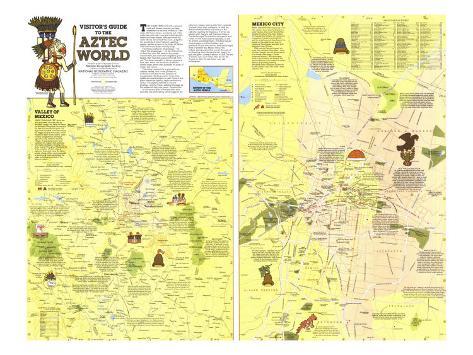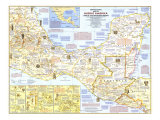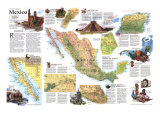The 1980 Visitors Guide to the Aztec World map features:
• Detailed map of the Valley of Mexico
• Map of Mexico City with modern points of interest such as Metro stations, public buildings, hospitals, and shopping areas, as well as archaeological sites within the city
• Inset map showing the extent of the Aztec World
• Index to places of interest
• A historical introduction
• Archaeological sites, the route of Cortes, ancient causeways, aqueducts, national parks, campgrounds
• Notes about a variety of archaeological sites
* Lesson plan idea - have your students update the information and latest disoveries concerning the Aztec civilization; discuss the political, economic, and environmental situations that are current for the region. • maps
THEY CAME FROM AZTLAN, a place of myth and dreams situated, perhaps, somewhere in the west of Mexico. they came, the fierce Aztecs, wandering out of the wilderness with their curel god Huitzilopochtli, feeder on human hearts, who gave them the name Mexica. Uncivilized they were, judged by the standards of other nahuatl-speaking people–earlier arrivals in the Valley of Mexico who lived in city-states ruled by kings.
The Aztecs settled on Cahpultepec–the “hill of the grasshopper”–in the 13th century. At first they were left alone by the people around them, but soon those neighbors grew to despise their fearsome ways and forced them out. The Aztecs moved to a barren expanse of lava, near where the University of Mexico stands today, where they subsisted on a diet of snakes and vermin.
There they remained for a generations as military vassals, first to the Culhuas of Culhuacan and later to the Tepanecs of Acapotalco. Seeking another home, they landed on a marshy island in Lake Texcoco at a place where they spied an eagle perched on a cactus. The sighting fulfilled an ancient prophecy, and the Atecs adopted the eagle as the emblem of their new home–Tenochtitlan.
As mercenary allies of Azcapotzalco they launched into unremitting warfare against the other city-states, sharing with their overlord the booty from their conquests. In 1428 the Aztecs established their supremacy in the valley by crushing the Tepanecs. A three-city alliance with Texcoco and Tlacopan (today's Tacuba) brought Tenochtitlan more power and riches. As the Aztec Empire expanded, so did its artistic accomplishments, including massive stone sculpture and fine feather-and gold work. By the 16th century they had brought most of present-day Mexico into a rich, tribute-paying empire that was at the peak of its flowering when Hernan Cortez, hungry for gold and glory, landed in Mexico in 1519. The end of empire came even faster than its rise: By August 13, 1531, the last Aztec ruler had surrendered.
VALLEY OF MEXICO -
SEVEN THOUSAND FEET above sea level and walled on three sides by mountain ranges, the Valley of Mexico has provide a favorable environemnt for man since the Glacial epoch. Ice Age hunters stalked mammoths along the boggy margins of its lakes, now a fraction of their former extent. Later, hunters and gathereres developed agricultrue and settled i nteh first villages. as population grew and exploited ther egion's rich potential, city-states developed, drawingfrom many sources throughout Mesoamerica in the evolution of their cultural patterns. Eventually came the Aztec people, whose military genius amassed an empire and firmly extablished the valley as the heart and hub of the Mexican nation.
MEXICO CITY -
FROM INAUSPICIOUS beginnings in the 14th century as an island settlement in Lake Texcoco, the city of Tenochtitlan became the seat of the Aztec Empire. Its huge painted temples, its canals and causeways, its palaces and markets, and the orderliness and cleanliness of its people so impressed Cortes that he compared Tenochtitlan favorably with the great cities of Spain.
With just 400 Spanish troops, but more than 100,000 Indian allies–some of whom thought him the reincarnation of a former ruler-priest– Cortes conquered the city. With the stones from its monuments, the Spanish laid the foundations of the capital of modern Mexico, a sprawling, teeming metropolis that is expected to become by this century's end, the world's most populous city.












